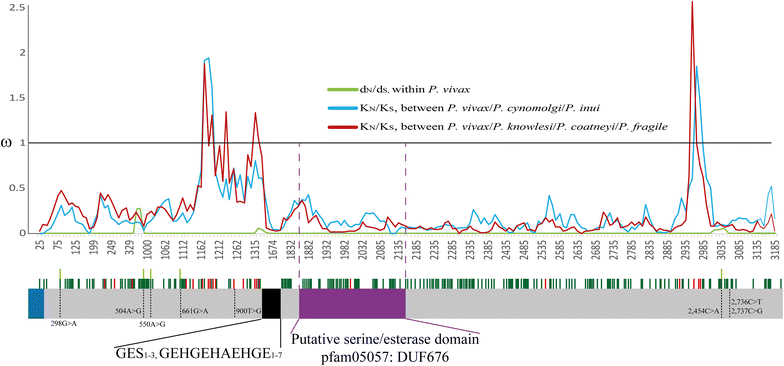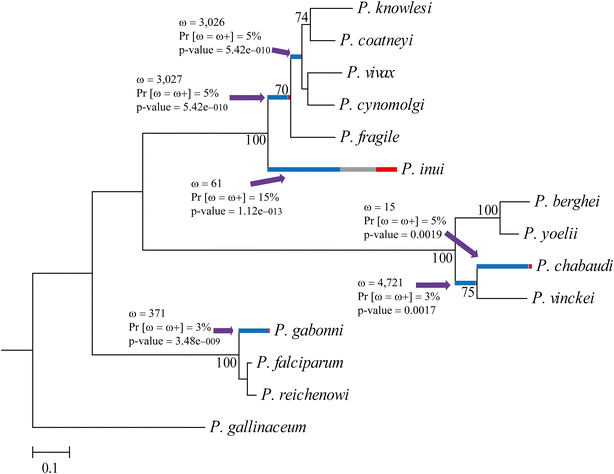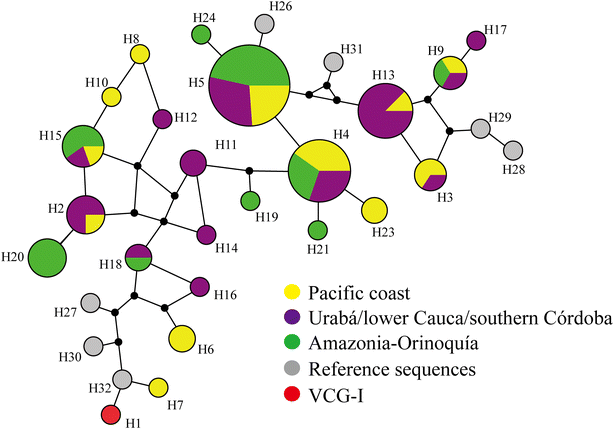Size polymorphism and low sequence diversity in the locus encoding the Plasmodium vivax rhoptry neck protein 4 (PvRON4) in Colombian isolates
- PMID: 27756311
- PMCID: PMC5069803
- DOI: 10.1186/s12936-016-1563-4
Size polymorphism and low sequence diversity in the locus encoding the Plasmodium vivax rhoptry neck protein 4 (PvRON4) in Colombian isolates
Abstract
Background: Designing a vaccine against Plasmodium vivax has focused on selecting antigens involved in invasion mechanisms that must have domains with low polymorphism for avoiding allele-specific immune responses. The rhoptry neck protein 4 (RON4) forms part of the tight junction, which is essential in the invasion of hepatocytes and/or erythrocytes; however, little is known about this locus' genetic diversity.
Methods: DNA sequences from 73 Colombian clinical isolates from pvron4 gene were analysed for characterizing their genetic diversity; pvron4 haplotype number and distribution, as well as the evolutionary forces determining diversity pattern, were assessed by population genetics and molecular evolutionary approaches.
Results: ron4 has low genetic diversity in P. vivax at sequence level; however, a variable amount of tandem repeats at the N-terminal region leads to extensive size polymorphism. This region seems to be exposed to the immune system. The central region has a putative esterase/lipase domain which, like the protein's C-terminal fragment, is highly conserved at intra- and inter-species level. Both regions are under purifying selection.
Conclusions: pvron4 is the locus having the lowest genetic diversity described to date for P. vivax. The repeat regions in the N-terminal region could be associated with immune evasion mechanisms while the central region and the C-terminal region seem to be under functional or structural constraint. Bearing such results in mind, the PvRON4 central and/or C-terminal portions represent promising candidates when designing a subunit-based vaccine as they are aimed at avoiding an allele-specific immune response, which might limit vaccine efficacy.
Keywords: Functional restriction; Genetic diversity; Natural selection; Plasmodium vivax; Rhoptry; Tandem repeat; pvron4.
Figures



Similar articles
-
Annotation and characterization of the Plasmodium vivax rhoptry neck protein 4 (PvRON4).Malar J. 2013 Oct 5;12:356. doi: 10.1186/1475-2875-12-356. Malar J. 2013. PMID: 24093777 Free PMC article.
-
Heterogeneous genetic diversity pattern in Plasmodium vivax genes encoding merozoite surface proteins (MSP) -7E, -7F and -7L.Malar J. 2014 Dec 13;13:495. doi: 10.1186/1475-2875-13-495. Malar J. 2014. PMID: 25496322 Free PMC article.
-
Low genetic diversity and functional constraint in loci encoding Plasmodium vivax P12 and P38 proteins in the Colombian population.Malar J. 2014 Feb 18;13:58. doi: 10.1186/1475-2875-13-58. Malar J. 2014. PMID: 24533461 Free PMC article.
-
The genetic diversity of Plasmodium vivax--a review.Mem Inst Oswaldo Cruz. 2007 Jun;102(3):245-54. doi: 10.1590/s0074-02762007000300002. Mem Inst Oswaldo Cruz. 2007. PMID: 17568928 Review.
-
The genetic diversity of Plasmodium vivax populations.Trends Parasitol. 2003 May;19(5):220-6. doi: 10.1016/s1471-4922(03)00085-0. Trends Parasitol. 2003. PMID: 12763428 Review.
Cited by
-
Plasmodium vivax Cell Traversal Protein for Ookinetes and Sporozoites (CelTOS) Functionally Restricted Regions Are Involved in Specific Host-Pathogen Interactions.Front Cell Infect Microbiol. 2020 Mar 24;10:119. doi: 10.3389/fcimb.2020.00119. eCollection 2020. Front Cell Infect Microbiol. 2020. PMID: 32266169 Free PMC article.
-
PvGAMA reticulocyte binding activity: predicting conserved functional regions by natural selection analysis.Parasit Vectors. 2017 May 19;10(1):251. doi: 10.1186/s13071-017-2183-8. Parasit Vectors. 2017. PMID: 28526096 Free PMC article.
-
Simultaneous detection of Plasmodium vivax dhfr, dhps, mdr1 and crt-o resistance-associated mutations in the Colombian Amazonian region.Malar J. 2018 Mar 27;17(1):130. doi: 10.1186/s12936-018-2286-5. Malar J. 2018. PMID: 29580244 Free PMC article.
-
Identifying Potential Plasmodium vivax Sporozoite Stage Vaccine Candidates: An Analysis of Genetic Diversity and Natural Selection.Front Genet. 2018 Jan 25;9:10. doi: 10.3389/fgene.2018.00010. eCollection 2018. Front Genet. 2018. PMID: 29422913 Free PMC article.
-
On the Evolution and Function of Plasmodium vivax Reticulocyte Binding Surface Antigen (pvrbsa).Front Genet. 2018 Sep 10;9:372. doi: 10.3389/fgene.2018.00372. eCollection 2018. Front Genet. 2018. PMID: 30250483 Free PMC article.
References
-
- Naghavi M, Wang H, Lozano R, Davis A, Liang X, Zhou M. GBD 2013 mortality and causes of death collaborators. Global, regional, and national age-sex specific all-cause and cause-specific mortality for 240 causes of death, 1990–2013: a systematic analysis for the Global Burden of Disease Study 2013. Lancet. 2015;385:117–171. doi: 10.1016/S0140-6736(14)61682-2. - DOI - PMC - PubMed
-
- WHO. World malaria report 2015. Geneva: World Health Organization; 2015. http://www.who.int/malaria/publications/world-malaria-report-2015/wmr201....
-
- UNICEF. Achieving the malaria MDG target. Reversing the incidence of malaria 2000–2015 http://www.unicef.org/publications/files/Achieving_the_Malaria_MDG_Targe....
MeSH terms
Substances
LinkOut - more resources
Full Text Sources
Other Literature Sources

